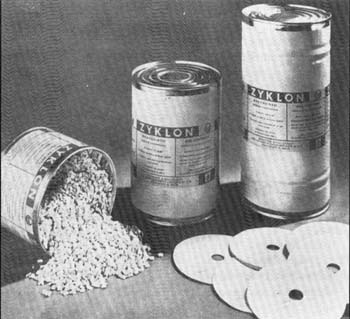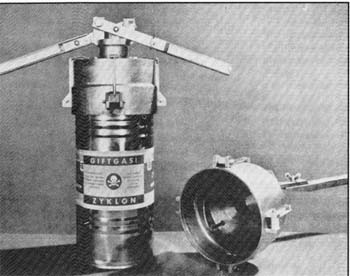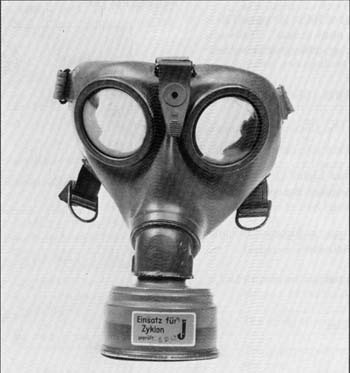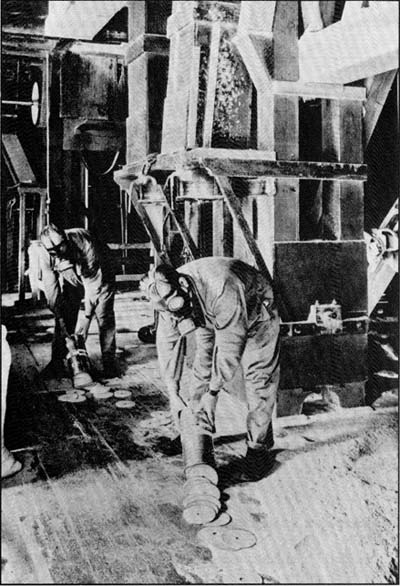
[Editorial notes: (a)The first column on page 17 was accidentally omitted in the original book. The missing text (below) appears on a separate errata issued by the publisher; (b) Images 9 and 10 in the original book are reversed; (c) Photo 12 is mislabeled as Photo 13 in the original publication]
Between 1939 and 1945, Dr. Peters, had many encounters with the law after the war. Attempts were made to make him admit that he was aware of the “Special” use of Zyklon-B, a product without warning agent [Photo 12: the added white label between the arrows. HCN being odorless, Degesch had founded the name “Zyklon” on the incorporation of 5% Bromessigester / bromacetic ester, giving a warning through its lachrymogenic and sternutative effects that the user was in hydrocyanic atmosphere. This explains the sore throats, coughs and watering eyes of members of the Sonderkommando. Towards the end of the war the percentage of warning agent was reduced because of a shortage in supply. Dr. Peters denied all knowledge of this, despite the fact that it appears he suspected a a small amount of “fraudulent” use of his product in the elimination of the “weak”, as in the euthanasia actions of 1939. He did not learn of its criminal and large-scale use at Auschwitz until the summer or autumn 1944, by which time it was too late to do anything and would he have done anything? We must bear in mind the suffocating and constricting context imposed by the Third Reich in war time. The scale of values, reactions and “normal” acts suffered an uncontrollable shift towards dehumanized behavior.
KL Auschwitz was supplied with Zyklon-B mainly by a firm called TESTA, an abbreviation for the Tesch und Stabenow Internationale Gesellschaft für Schädlingsbekämpfung / International pest control company, domiciled at Messberghoff, Hamburg 1. This company had the monopoly for distributing Zyklon-B in the eastern territories of the Reich (in fact to the east of the Elbe). But the Auschwitz SS, having at the same time to combat epidemics and carry out the “special treatment” of Jews, sometimes turned directly to Degesch (located in 1939-45 at 43, Schaumainkai, or 9, Weissfrauenstreasse, Frankfurt-am-Main, then at 70, Kaiserstrasse, Friedberg/Hessen) to obtain quantities sufficient for their needs. For this reason a five-ton truck with a trailer ran back and forth between Auschwitz and the factory producing Zyklon-B, the DESSAUER WERKE für Zucker- und Chemische Industrie AG, 40 Askanische Strasse, Dessau (about 50 kilometers north of Leipzig). The “reserve stocks” of the PMO have cans of Zykon-B from both sources: Testa and Degesch (Dessauer Werkr). Zyklon-B without irritant (ohne Reizstoff) was delivered by the Dessauer Werke as from August 1942. This was because a LACK of the warning agent generally used, a bromoacetic ester. The Degesch laboratory people, who had remained at Frankfort, would have liked to replace it by a chlorinated carbon dioxide ester [methyl chloroformiate] with a suffocating effect, but the Friedburg management decided to produce Zyklon-B with no warning agent.
The head of Testa, Bruno Tesch, was judged by the British Military Tribunal in Hamburg between 1st and 8th March 1946. He was condemned to death simply on the verbal testimony of one of his employees, the book keeper Emil Sohm, who declared that in autumn of 1942. he had seen among the firm’s records, a report of a visit, dictated by Bruno Tesch, in the course of which he is supposed to have suggested to Wehrmacht officers who told him of the “difficulties” caused by the mass executions of Jews by shooting, that they should kill them in disinfestation gas chambers using HIS product. Zyklon-B (business first!) containing a powerful poison, prussic acid. In 1940, simple malicious gossip could easily lead to someone being hung. I do not know whether the “trip report” was produced before the Tribunal, but is if was not, then, this trial was a masquerade.
|
||
| Photo 8 | ||
 |
 |
|
| Photo 9 | Photo 10 | |
 |
||
| Photo 11: Regulation gas mask for the Third Reich Armed forces, type GM 38, made of synthetic rubber with five points for attachment to the wearer’s head. It is fitted with a “J” type filter cartridge reserved for use with Zyklon-B. (Photo by Pierre Besson) | ||
 |
||
| Photo 12 [PMO neg. no. 1195] Degesch label with red printing on a yellow background, of a 500g can of HCN with an added white label: "Vorsicht, ohne Warnstoff! / Take care, no warning agent!" undated. |
||

